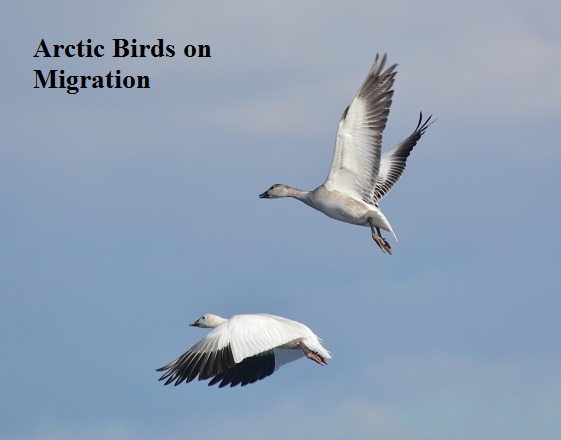
Updated 29 Jan 2023
Many Arctic birds are large white birds such as geese and swans but include smaller and different coloured sandpipers and other birds.
Where is the best place to see to view these magnificent Arctic birds? The most common answer would be in the “Arctic”; however, this would not be correct. The Arctic birds spread out in pairs all along the Arctic coast for breeding during the summer. Finding and photographing all of them would be difficult and very expensive. There is a better place.
See Arctic Birds Migration in Saskatchewan
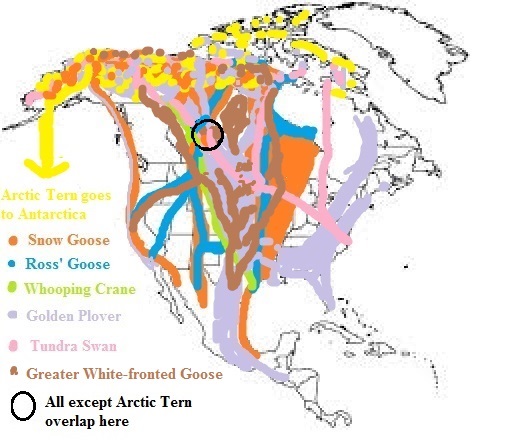
The best place to see Arctic birds is near Saskatoon, Saskatchewan, Canada. Arctic birds spend the winter in various locations such as the west and east coasts of the southern USA, Texas Gulf coast, Mexico and even further south. However, most Arctic birds pass through central Saskatchewan on their way south during migration. Not only do they pass through here, but they stop to rest and feed and remain here for several weeks. Therefore, this is a wonderful opportunity for bird watchers and photographers to see most Arctic birds without even going to the Arctic.
The map above shows the migration routes of several Arctic birds. Although they have different destinations, all except the Arctic Tern pass through the circle around Saskatoon, Saskatchewan. The time to see them is in October.
Snow Goose
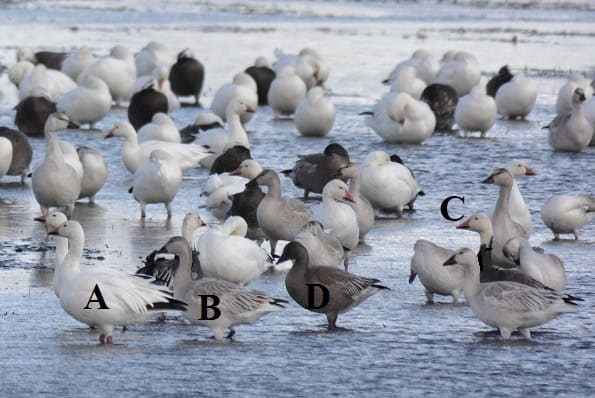

Snow Geese breed in the high Canadian Arctic and the north coast of Alaska, and northwest Greenland. In winter, they migrate to various places in the southern United States and northern Mexico.
The easiest of the Arctic birds to find is the Snow Goose. It is a pretty bird for a goose. Adults are pure white with black wingtips (labelled A in the photo above), but you might see three other types of Snow Geese. Immature birds are light grey (B). There is a dark phase called the Blue Goose (C), which is a very dark grey with a white head. Immature Blue Geese are dark grey all over, including the head (D). Snow and Blue Geese are, in reality, the same species. They interbreed, and the chick could be either colour.

Seeing a Snow Goose is lovely, but what is spectacular is seeing a flock of thousands of them all at once. They travel in huge flocks, and I have seen more than 25,000 at a time. I saw a massive flock fly overhead that blocked the sky for several minutes. The population of Snow Geese is more than five million, not including juveniles of the current year.
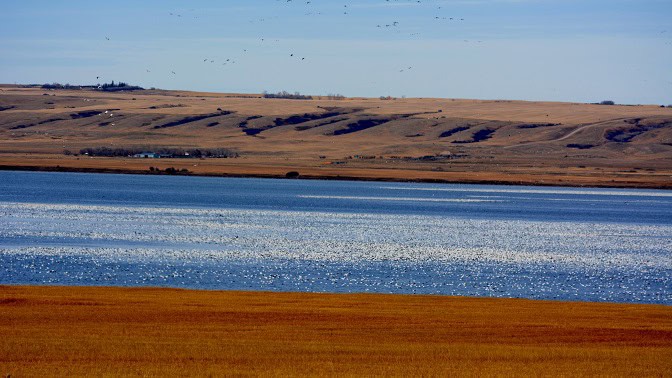
Look for Snow Geese on many ponds and lakes around Saskatoon. In the last photo above, a flock of Snow Geese cover a lake like snow in winter. Guess that is why they are called Snow Geese.
Tundra Swan
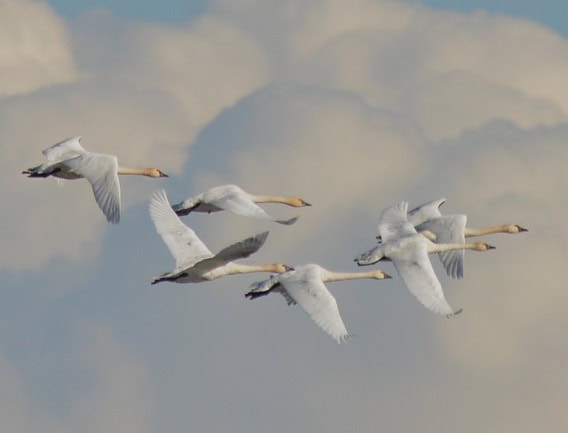
You might be lucky enough to see some Tundra Swans mixed in with the Snow Geese. These huge, beautiful birds live along the Arctic Coast of Canada and Alaska and Siberia. The ones from Siberia migrate to southeast Asia and Europe. North American birds migrate to the southern United States. The Tundra Swan is a magnificent bird. It is all white except for its black bill and brownish head and neck.
There are two species of swans in North America. The other is the Trumpeter swan which lives in Alaska and northwest Canada but not as far north as the Arctic Coast, where the Tundra Swans spend the summer. They migrate down the west coast to the Vancouver area in winter.
Tundra Swans don’t fly in huge flocks, like the Snow Geese, but seeing even a couple of these huge, beautiful, white birds is a thrill.
Ross’ Goose

Look carefully at the huge flocks of Snow Geese. Mixed in with them might be some Ross’ Geese. These geese are often overlooked as they are much the same as the Snow Goose. However, they are smaller and have a very different bill than the Snow Goose. They have a stubby bill, and the lower mandible is the same orange as the top instead of black as on the Snow Goose. Also, the bill is more orangish and has a slightly bluish tint at the base.
They breed in a very small area on the Arctic Coast of central Canada and along the west coast of Hudson’s Bay. In winter, they migrate to the southwest United States and Mexico.
Cackling Goose
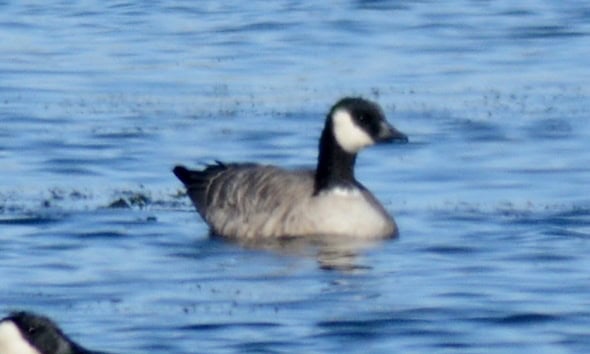
The Cackling Goose is a small, Arctic version of the ubiquitous Canada Goose. It is the same colour as the Canada Goose, but some differences exist. The Canada Goose lives all over North America, except along the Arctic coast, where the Cackling Goose breeds. The Canada Goose has a large bill, but the Cackling Goose has a short, stubby bill. The Cackling Goose is smaller and has a small white ring around its neck, but not on all birds. During winter, they migrate to the southwestern United States and northern Mexico.
Whooping Crane

The premier prize of migrating Arctic Birds is the Whooping Crane. They breed in Wood Buffalo National Park in Canada’s Northwest Territories, which is south of the Arctic Circle and so technically not an Arctic Bird, but too magnificent to leave out of this story.
The Whooping Crane is a success story of a bird that has bounced back from the edge of extinction. Before Europeans arrived in Norther America, there were probably more than 10,000 of these magnificent birds. In the 1940s, there were only 21 Whooping Cranes left. Through conservation efforts of the Canadian and American governments, the population is now 543, and other 75 in an eastern flock that migrates from the Great Lakes area to Florida andl161 in captivity.
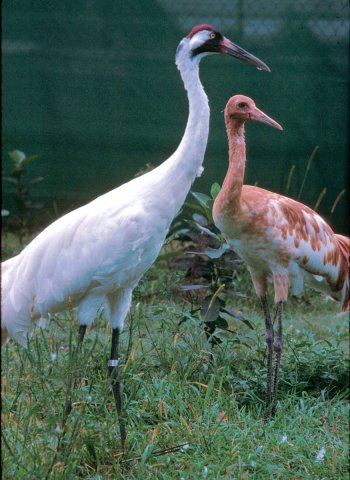
In late September and early October, they migrate to Aransas National Wildlife Refuge on the gulf coast of Texas. They do not migrate in flocks, and they do not all leave simultaneously. Instead, they travel in small family groups spread over a month or more apart. Some Whooping Cranes might arrive in Texas before others have left the Northwest Territories. It takes them two or three days to get to the Saskatoon area, where they stop for a couple of weeks. They make several other stops between here and Texas but only for short periods of time. This is an excellent opportunity to see an extremely rare endangered species.
The Whooping Crane is the tallest bird in North America, standing at 1.5 meters (five feet) tall. Immature birds, on their first migration, are a bit shorter and are a mottled brown and white.
Wood Buffalo National Park was created in 1922 to protect the almost extinct Wood Bison and the Whooping Crane. I have been to Wood Bison National Park and Aransas in Texas, and this year I saw another 18 birds bringing my total Whooping Crane sightings to almost 10 per cent of the total population. Unfortunately, few people have seen even one of these beautiful birds.
American Golden Plover and Black-bellied Plover
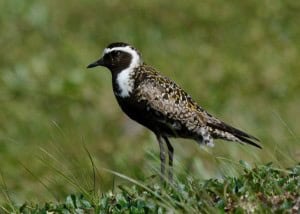
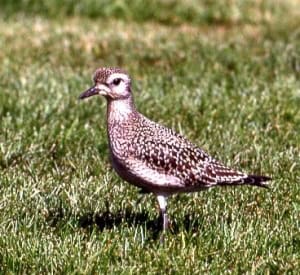
Other Arctic birds you might find on migration in Saskatchewan are the American Golden Plover and the Black-bellied Plover. These are small, beautiful birds, but unfortunately, they change colour during the winter, and by the time they get to Saskatchewan, they are a dull grey or perhaps somewhere between these two colour phases.
The photos above show the American Golden Plover in summer and winter plumage. I took the summer photo on the Arctic tundra. By the time they get to Saskatchewan, they have changed into their winter plumage. So the only way to see them in their beautiful summer colours is to travel to the Arctic.
However, suppose you are lucky, in the early days of fall. In that case, you might see an American Golden Plover or Black-bellied Plover on migration that has not yet changed to its winter colours, or sometimes they appear in a faded version of their breeding colours.

The photo on the left is the Black-bellied Plover which is very similar in colour to the Golden Plover during the summer but without the gold spots. The winter plumage is the same colour as the Golden Plover but lighter.
Greater White-fronted Goose
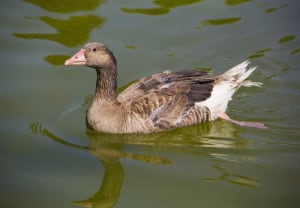
This brown goose lives along the Arctic coast and migrates to Texas and Mexico.
Arctic Tern
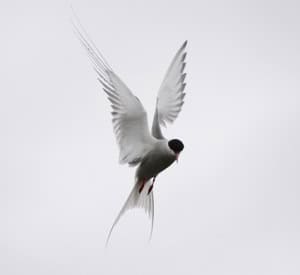
The Arctic Tern looks much like the Common Tern that can be found further south, but this is an Arctic bird. This is one that you will not see in Saskatchewan. They migrate down the west coast, past North America, past South America, and on to Antarctica. They spend the winter (Antarctic summer) in Antarctica and, in the spring, make the return trip to the Canadian Arctic and Alaska. This is a fantastic round trip of about 71,000 km (44,000 miles). As they can live for almost 30 years, this equals three round trips to the moon.
Read about the Trumpeter Swan Migration northward
All photos on this page are copyrighted and must not be copied without written permission. All images are the property of Birdtripper, except the image of the immature Whooping Crane, which is used courtesy of the International Crane Foundation.